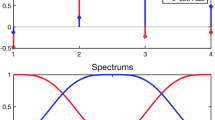Abstract
Medical imaging problems, such as magnetic resonance imaging, can typically be modeled as inverse problems. A novel methodological approach which was already proven to be highly effective and widely applicable is based on the assumption that most real-life images are intrinsically of low-dimensional nature. This sparsity property can be revealed by representation systems from the area of applied harmonic analysis such as wavelets or shearlets. The inverse problem itself is then solved by sparse regularization, which in certain situations is referred to as compressed sensing. This chapter shall serve as an introduction to and a survey of mathematical methods for medical imaging problems with a specific focus on sparsity-based methods. The effectiveness of the presented methods is demonstrated with a small case study from sparse parallel magnetic resonance imaging.
Similar content being viewed by others
References
Epstein CL. Introduction to the mathematics of medical imaging. Philadelphia: SIAM; 2008.
Lustig M, Donoho D, Pauly JM. Sparse MRI: the application of compressed sensing for rapid MR imaging. Magn Reson Med. 2007;58:1182–95.
Hadamard J. Lectures on Cauchy’s problem in linear differential equations. New Haven: Yale University Press; 1923.
Grafakos L. Classical Fourier analysis. New York: Springer; 2008.
Foster J, Richards FB. The Gibbs phenomenon for piecewise-linear approximation. Am Math Mon. 1991;98:47–9.
Bertero M, Boccacci P. Introduction to inverse problems in imaging. London: Institute of Physics Publishing; 1998.
Mueller JL, Siltanen S. Linear and nonlinear inverse problems with practical applications. Philadelphia: SIAM; 2012.
Tikhonov AN, Arsenin VY. Solutions of ill-posed problems. New York: Wiley; 1977.
Candès EJ, Tao T. Decoding by linear programming. IEEE Trans Inf Theory. 2005;51:4203–15.
Donoho DL. Compressed sensing. IEEE Trans Inf Theory. 2006;52:1289–306.
Boche H, Calderbank R, Kutyniok G, Vybiral J. A survey of compressed sensing. In: Boche H, et al., editors. Compressed sensing an its applications. Berlin: Springer; 2015.
Tropp JA, Wright SJ. Computational methods for sparse solution of linear inverse problems. Proc IEEE. 2010;98:948–58.
Candès EJ, Plan Y. A probabilistic and RIPless theory of compressed sensing. IEEE Trans Inf Theory. 2010;57:7235–54.
Candès EJ, Tao T. The Dantzig selector: statistical estimation when p is much larger than n. Ann Statist. 2007;35:2313–51.
Tibshirani R. Regression shrinkage and selection via the Lasso. J R Stat Soc Ser B Methodol. 1996;58:267–88.
Rudin L, Osher S, Fatemi E. Nonlinear total variation based noise removal algorithms. Physica D. 1992;60:256–86.
Chambolle A, Lions P. Image recovery via total variation minimization and related problems. Numer Math. 1997;76:167–88.
Mallat S. A wavelet tour of signal processing: the sparse way. 3rd ed. Amsterdam: Elsevier/Academic; 2009. With contributions from Gabriel Peyré
Daubechies I. Ten lectures on wavelets. Philadelphia: SIAM; 1992.
Donoho DL. Sparse components of images and optimal atomic decomposition. Constr Approx. 2001;17:353–82.
Kutyniok G, Labate D. Shearlets: multiscale analysis for multivariate data. Boston: Birkhäuser Basel; 2012.
Guo K, Kutyniok G, Labate D. Sparse multidimensional representations using anisotropic dilation and shear operators. In:Wavelets and Splines (Athens, GA, 2005). Nashville: Nashboro Press; 2006. p. 189–201.
Labate D, Lim W-Q, Kutyniok G, Weiss G. Sparse multidimensional representation using shearlets. In: Papadakis M, Laine MF, Unser MA, editors. Wavelets XI, SPIE proc. 5914. Bellingham, WA: SPIE; 1974. p. 254–62.
Kittipoom P, Kutyniok G, Lim W-Q. Construction of compactly supported shearlet frames. Constr Approx. 2012;35:21–72.
Christensen O. An introduction to frames and Riesz bases, Applied and numerical harmonic analysis. Boston: Birkhäuser Boston; 2003.
Kutyniok G, Lemvig J, Lim W-Q. Optimally sparse approximations of 3D functions by compactly supported shearlet frames. SIAM J Math Anal. 2012;44:2962–3017.
Pruessmann KP, Weiger M, Scheidegger MB, Boesiger P. SENSE: sensitivity encoding for fast MRI. Magn Reson Med. 1999;42:952–62.
Kutyniok G, Lim W-Q, Reisenhofer R. ShearLab 3D: faithful digital shearlet transforms based on compactly supported shearlets. ACM Trans Math Softw. 2016;42:1–42.
Combettes PL, Pesquet J-C. Proximal splitting methods in signal processing. In:Fixed-point algorithms for inverse problems in science and engineering. New York: Springer; 2011. p. 185–212.
Ma J, März M. A multilevel based reweighting algorithm with joint regularizers for sparse recovery (submitted).
Ma J, März M, Funk S, Schulz-Menger J, Kutyniok G, Schäffter T, Kolbitsch C. Shearlet-based compressed sensing for fast 3D MR imaging using iterative reweighting (submitted).
Acknowledgements
G. Kutyniok acknowledges partial support by the Einstein Foundation Berlin, the Einstein Center for Mathematics Berlin (ECMath), the European Commission-Project DEDALE (contract no. 665044) within the H2020 Framework Program, DFG Grant KU 1446/18, DFG-SPP 1798 Grants KU 1446/21 and KU 1446/23, the DFG Collaborative Research Center TRR 109 Discretization in Geometry and Dynamics, and by the DFG Research Center Matheon “Mathematics for Key Technologies” in Berlin. J. Ma acknowledges partial support by the DFG Collaborative Research Center TRR 109 Discretization in Geometry and Dynamics. M. März acknowledges partial support by the DFG SPP 1798 Compressed Sensing in Information Processing.
Author information
Authors and Affiliations
Corresponding author
Editor information
Editors and Affiliations
Rights and permissions
Copyright information
© 2018 Springer International Publishing AG
About this chapter
Cite this chapter
Kutyniok, G., Ma, J., März, M. (2018). Mathematical Methods in Medical Image Processing. In: Sack, I., Schaeffter, T. (eds) Quantification of Biophysical Parameters in Medical Imaging. Springer, Cham. https://doi.org/10.1007/978-3-319-65924-4_7
Download citation
DOI: https://doi.org/10.1007/978-3-319-65924-4_7
Published:
Publisher Name: Springer, Cham
Print ISBN: 978-3-319-65923-7
Online ISBN: 978-3-319-65924-4
eBook Packages: MedicineMedicine (R0)




